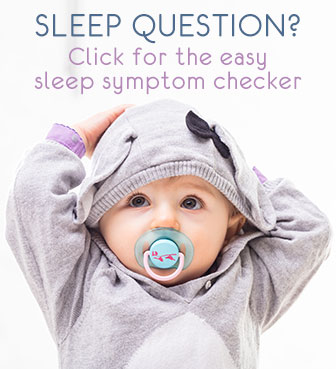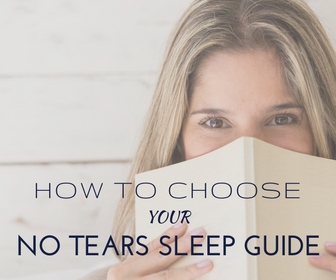Wake Windows By Age: Month by Month Recommendations
Author Name: Heidi Holvoet, PhD
Understanding your baby's wake windows — the amount of time your baby is awake between sleeps — is essential for creating a balanced nap schedule.

Thanks to a lot of experiental research, we now have reliable typical wake windows by age. The National Sleep Foundation publishes recommended sleep duration per day, by age. Combined with recommended nap frequency these also support the wake windows we use.
Full overview of age-appropriate awake times by month right below.
Age-appropriate wake windows are super useful. You understand your baby's natural rhythms and can set up an efficient sleep schedule to help:
- avoid under- and over-tiredness,
- promote easy settling and self-soothing,
- stay asleep for longer stretches
In this way, well-chosen wake windows strongly support sleeping through the night.
How strictly should you follow wake windows by age?
Answer: Not strictly! Because that can lead to frustration and potentially worse sleep.
Wake windows are excellent as guidelines to create a nap schedule to start from. These guidelines offer typical, average numbers.
Average also means that many babies are on either side of these numbers. Your individual baby or toddler's sleep needs will naturally. That's why you'll ideally adjust the pre-scribed wake windows to your little one's individual needs.
They may be on the very low end of nap needs for their age, and be OK with much longer wake windows. Or need more naps than prescribed, and shorter wake windows.
Don't let this worry you: I'll explain below how to know what your baby needs, and how to balance all this.
Wake windows month by month
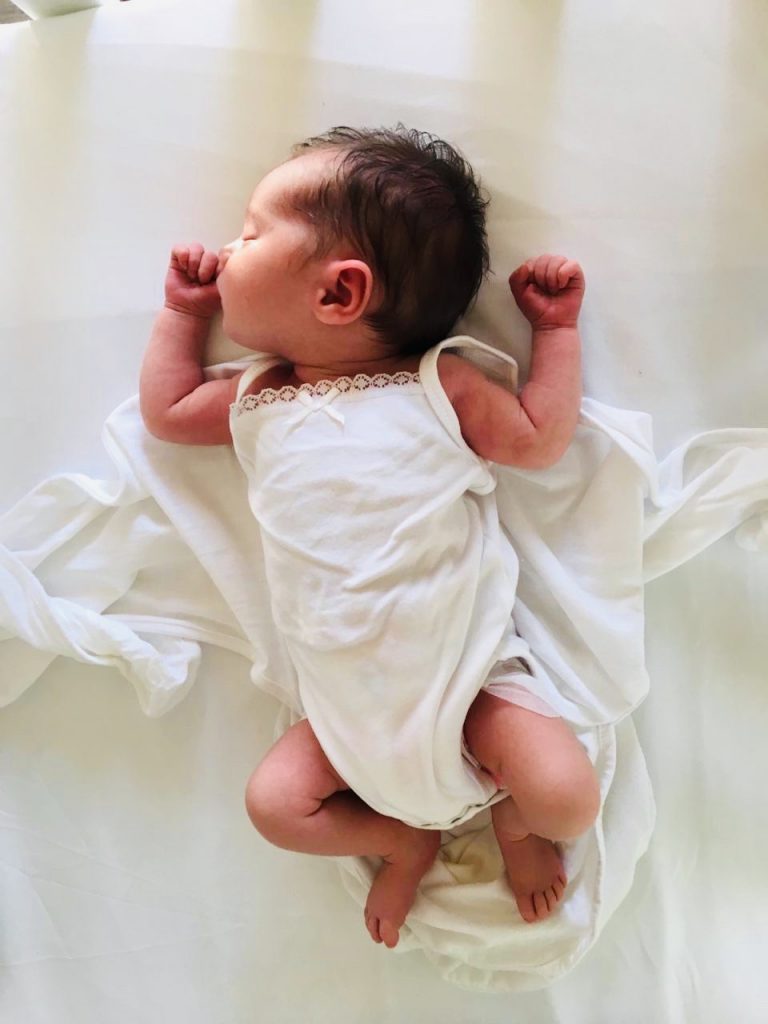
Newborn baby (0, 1, 2 months)
For newborns their wake windows are usually between 45 minutes to an hour.
Indeed it means your little one may be ready for a nap just about an hour after waking up.
This can seem like a lot of daytime sleep. But remember that your baby is in a crucial stage of growth that requires plenty of rest. Their circadian rhythms are naturally adapted for this.
Naps and Sleepy Signs
Naps are on-demand, average about 4-5 a day, and vary in length (between 20' to 2 hours).
Make a point of observing your baby closely. Their sleepy signs may not be very clear yet, but by paying attention, you'll learn to recognize some cues.
The value of this toward sleep in later months is huge!
Typical variations to newborn wake windows
It's very common for a newborn baby to stay awake for longer than an hour at specific times of day.
For many this can be the late afternoon, and yet others tend to have more wakeful periods in the mornings.
This is 100% fine. All you have to do is offer ample opportunity to sleep. Just know that there's no pressure of always having to sleep right at that 1 hour mark.
More about sleep schedules by age.
2, 3, 4 month old baby

As your baby hits the 2-3 months mark, their wake windows expand slightly to between 1-2 hours, with fluctuations. And lengthen toward 4 months of age.
Your baby is briskly developing and exploring the world a bit more, hence the increased wakefulness.
It’s a delicate balance and at the same time for most a rather easy and calm period for daytime naps.
Naps and Sleepy Signs
Naps are still on-demand and single sleep cycle naps are the norm at this age. This means that some naps may be longer, but on average naps of 40-60 minutes are normal and expected.
Observe your baby, and look for clear or subtle sleepy signs. The cues may not be easy to recognize yet and won't be always the same.
But simply paying attention will teach you a lot! And they'll help you adjust your baby's schedule to real sleep needs. Guided by the wake windows, but not following them blindly.
Typical variations to 2-4 month old wake windows
Averaged over a whole day, many babies at this age are indeed really close to the wake window of 1-2 hours. But it usually varies in the course of the day.
Your baby might need a nap very soon after waking for the day. And be able to go for a bit longer in the afternoon.
This is normal and expected. Your power will be to know this: wake windows are good guidelines, ideally fine-tune to your baby's sleepy cues.
More about sleep schedules by age and setting up a bedtime routine.
4, 5, 6 month old baby
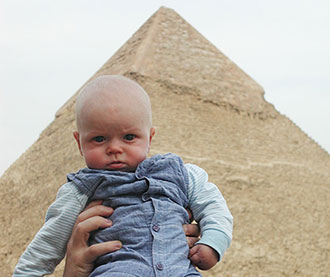
Between 4-6 months, things start to take a more predictable shape, and your baby's wake times gradually increase to about 2-2.5 hours.
Your tiny explorer is learning more about their environment, and that curiosity fuels their wakefulness. This wakefulness is good!
It helps with a healthy balance between active and calm. This nurtures healthy tiredness levels and sleeping habits.
Naps and Sleepy Signs
Typically 4 down to 3 naps, just 2 naps for some.
At 4 months old, single sleep cycle naps are still the norm meaning most unassisted naps will be less than an hour.
Toward 5 and 6 months old some of the naps can gradually become longer. Your baby may need your assistance to lengthen them at first. This can coincide with gentle self-soothing practice.
Try and become a pro at recognizing your baby's sleepy signs. The better you recognize even the subtlest signs, the easier you'll be able to set up a regular schedule.
A timed schedule regulate sleep and is ideal from about 5-6 months old. Not a rigid schedule but one with enough flexibility to keep it realistic.
Typical variations to 4-6 month old wake windows
The 2-2.5 hour wake windows can be quite exact when averaged over a whole day. But for most babies their ideal wake window will change as the day wears on. Shorter times awake earlier in the day, and a bit longer later in the day.
I have to say it though: some babies do the reverse! And are happier with longer awake times in the mornings, and need sleeps closer together later in the day.
Again the key is this. 1/ be aware of typical wake windows and nap schedules. 2/ fine-tune based on what your baby shows you they need.
6, 7, 8, 9 month old baby
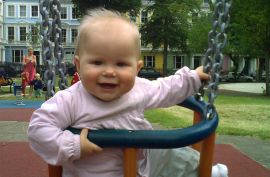
For babies 6-9 months of age, the typical wake window ranges from 2-2.5 hours when on 3 naps and 2-4 hours on 2 naps.
At this age, babies are becoming more social and active, meaning they might begin to resist sleep a little more.
It's good to acknowledge this. At the same time remember that you're the adult, who knows that your baby needs a given amount of sleep.
Naps and Sleepy Signs
3 down to 2 naps for most.
From 6 months onward most babies will thrive on a timed schedule. NOT a rigidly timed one. A schedule that offers enough consistency to regulate your baby's sleep. At the same time it should be flexible enough to be realistic (and actually work).
I help parents almost daily with such nicely adjusted sleep schedules inside Overcome Frequent Waking. And we see lovely results for improved nights too.
You'll still use your baby's sleepy cues except be careful not to overly rely on them. Because if your baby had a choice, especially if they're full-on active and exploring, they'd tell you they're never tired!
Typical variations to 6-9 month old wake windows
Your baby's sleep has matured a lot by now and that means that it becomes less erratic. Or at least, can be less erratic, especially if supported by a nicely consistent nap and night sleep schedule.
This also means that the wake windows are quite reliable for many babies. They'll naturally evolve along with the transition from 3 down to 2 naps.
That said, if you find yourself constantly battling the so-called pre-scribed wake windows and numbers of naps, remember that they're not absolute truth.
There's a good chance that your baby simply is a bit, or a lot, further on the scale than the average.
9 - 15 month old baby
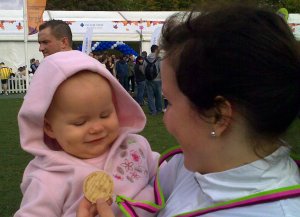
When your baby reaches 9-15 months, they'll have wake windows ranging from 2-6 hours. This varies through the day and increases as nap frequency reduces.
The longer wake periods allow for active play which promotes their cognitive, social, and physical development.
Naps and Sleepy Signs
With huge variations between babies for when it happens, most will transition from 2 to 1 naps between 9 and 15 months old.
Ladder schedules are typical when still on 2 naps. This means wake windows increasing during the day. 2 hours before first nap, 3 between naps, and 4 hours between last nap and bedtime.
Don't be surprised though if your baby does better on a reverse ladder, that is totally fine too!
The final nap of the day is normally a short nap.
When on 1 nap we typically expect 4-6 hours before the nap, and then 4-5 between nap and night bedtime. With the nap transition there's usually also an earlier bedtime.
The most important guide now to supplement the average wake windows and nap schedules is to avoid over-tiredness.
Typical variations to 9-15 month old wake windows
The wake windows when still on 2 naps can vary quite a bit before the transition down to 1 nap. Your baby may start lengthening wake windows in the early morning first, to 3-4 hours.
Once well settled into a 1 nap schedule, the average of 5 hours awake between sleeps is pretty reliable for most. This leads to well-balanced 24-hour sleep.
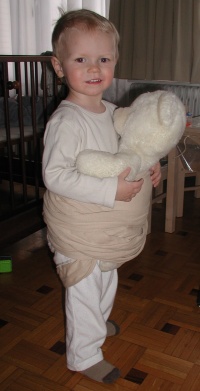
15 - 36 months old toddler
Once on a 1-nap schedule, babies over 15 months old can typically stay awake for 4-6 hours.
These extensions in wake windows reflect your toddler's growing independence and activities.
You might also enjoy the increased flexibility for yourselves when planning your days, outings, holidays, etc.
Naps and Sleepy Signs
Even if it's only 1 a day, your toddler's nap is hugely important right now. While some are good with just 1-2 hours, for some it even becomes a surprisingly long sleep (3-4 hours are no big exception!).
Get in touch for a 1:1 or join Overcome Frequent Waking if this worries you or leads to poor sleep at night. There are several actions we can take to steer your baby to optimally balanced sleep both day and night.
36+ months old
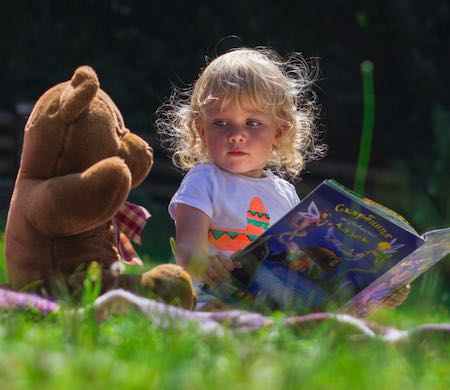
Naps are always beneficial.
As long as you keep offering a natural rest moment in the day, your little one might take a nap on some days. And simply rest on other days. This is ideal.
There will of course come a time when napping stops.
It usually starts with not taking a nap once in a while and being OK with it.
Then nap again for a few days. Then again not. And so on, until one day you'll realize that they've outgrown this stage.
Even then: always keep the option open. A nap is useful to re-charge batteries. And it's shown to support psycho-social development at any age.
Remember, these age-based wake windows are averages and not strict rules. Some babies may need more hours of sleep, others less.
The key is to react to your baby’s sleep cues, achieving a perfect harmony between these general guidelines and your baby's individual needs.
How to recognize your baby's sleepy signs?
Paying attention to your baby's sleepy signs help adjust the schedule for daytime sleep and night time sleep to their needs. These sleep cues are the key to avoiding an overtired baby.
Don't feel discouraged if you don't easily recognize your little one's signs: not every baby shows them clearly.
But if you consciously observe you will probably start recognizing some of the signs, even if they're very subtle.
What your baby shows as sleepy signs will also vary with age. At 9 months old, your baby may have completely different way of showing they're tired than they did at 4 months old.
This is a list of sleepy signs. You'll see typical and less common ones.
- Yawning
- Rubbing eyes
- Rubbing face
- Rubbing/pulling ears
- Staring in the distance
- No interest in interacting
- Becoming hyper-active
- Getting fussy
- Not seeming to find a good way to sit/lie down
- Frustrated when playing
- Not wanting to eat
- Restless
- Restless at the breast/bottle
Hidden or "fake" sleepy signs
Sometimes your baby will show textbook sleepy signs without being really tired.
There are a few typical causes - other than being sleepy - of yawning, eye rubbing and/or losing interest in environment:
- Hungry
- Need to make a bowel movement
- Bored
Try and not let this frustrate you - I know it's difficult enough already to recognize your baby's signs, let alone having to think of possibly fake sleepy signs. And trying to start a nap or bedtime based on a false sign can get very frustrating, I know.
But just keep in mind the possibility:
if you feel you're contantly battling against expected/prescribed nap times and wake windows, and how easy or difficult it is for your baby to settle: consider if maybe one or more of the above non-sleepy signs are happening.
Get in touch (1:1 or supported group program) if you'd like my help with this.
Recommended sleep duration by age
You may also find the graph below interesting. It was published by the National Sleep Foundation and gives an interesting overview of average and excess sleep durations by age. Taken from doi: 10.1016/j.sleh.2014.12.010.
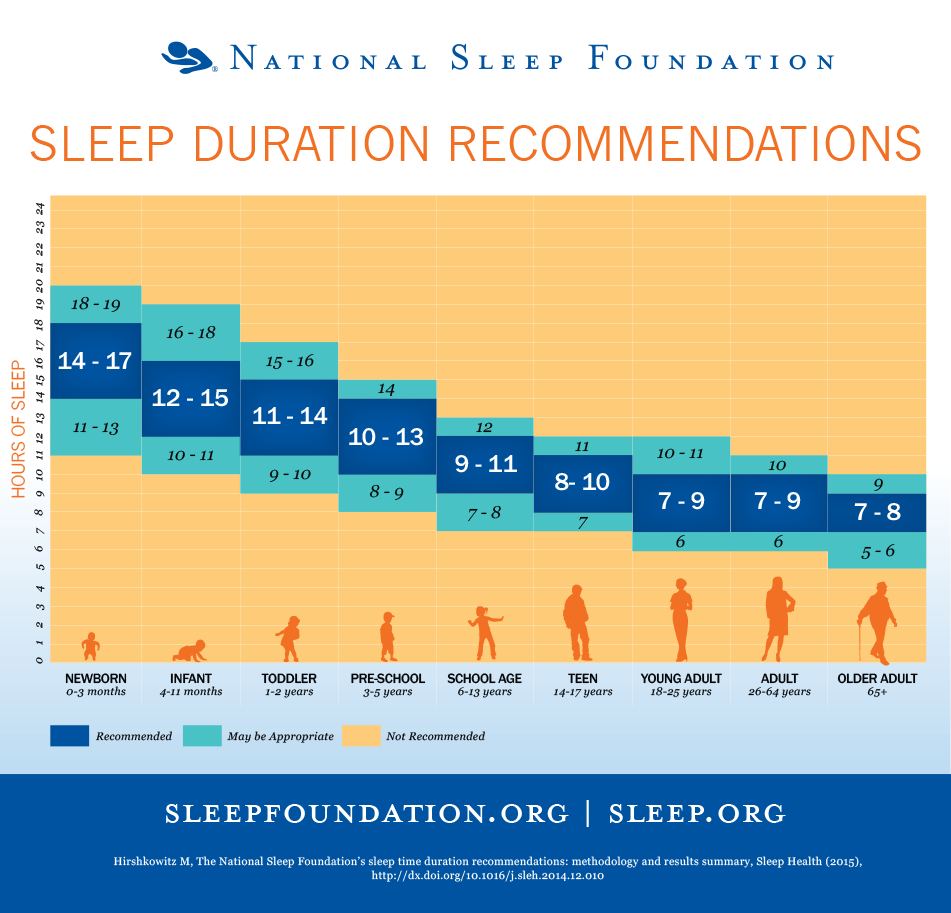
Beautiful picture of girl reading book to teddy bear by Andy Kuzma on pexels.
Article Author: Heidi Holvoet, PhD - Founder, senior sleep consultant

Heidi Holvoet, PhD, is the founder of the Baby Sleep Advice website and movement, an award-winning author, baby & toddler sleep consultant with 17+ years experience as well as a certified lactation counselor.
Over the years, Heidi has received several awards inluding a Mom's Choice Award (MCA) and National Parenting Awards (NAPPA) for her Baby Sleep Advice website, programs and books. Also, Baby Sleep Advice was awarded "Most Trusted Infant's Sleep Solutions Company 2023" in the Benelux Enterprise Awards 2023.
Heidi continually conducts personal research and participates in continued education and in that way stays up to date with current scientific and pyschosocial infant care.
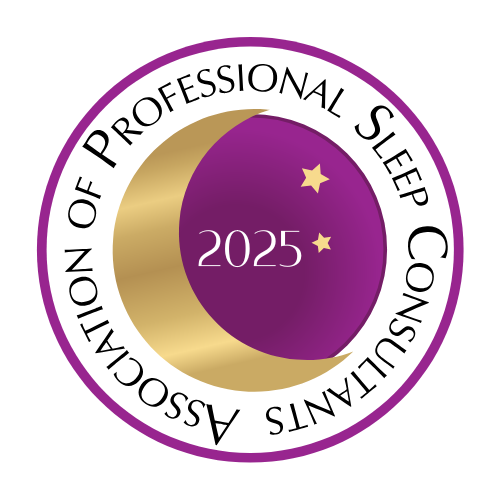
She is also a member of the Association of Professional Sleep Consultants of which she was one of the earliest contributors. She obtained her PhD degree in physics at the University of Ghent in Belgium.
Heidi is passionate about helping babies and their parents sleep more and better, with her trademark holistic and truly-no-tears approach that has been proven and praised time and again by parents worldwide to be effective and truly no-tears. Respect for you as a parent and your baby, is at the heart of Heidi's warm and kind support. Her approach always keeps in mind a baby's needs and abilities at any given age, is based on pediatric science and the most up to date knowledge in infant care and sleep science.
As well as the award-winning baby sleep programs, Heidi offers popular 1:1 consults and easy-access 30-minute SOS Sleep sessions.

Self Soothing
by Heidi Holvoet, PhD

What to do when your baby wakes every hour
by Heidi Holvoet, PhD

Separation Anxiety
by Heidi Holvoet, PhD

Colic
by Heidi Holvoet, PhD

Why does my baby wake up every hour?
by Heidi Holvoet, PhD
© 2008-2025 Copyright Baby-Sleep-Advice.com Heidi Holvoet. All rights reserved.



